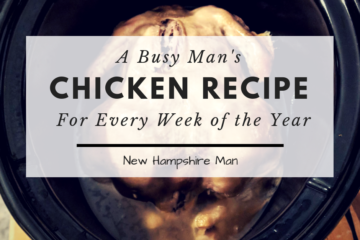Growing food is a lot harder than most people think. If you’re going to take the time and energy to learn how to grow your own food, think about growing storage crops that you can enjoy all year long.
The trick is to find plants that are easy to grow, store well, and are a delight to eat. These are my top 7 picks.
One Unspoken Impact of Big Ag
It’s safe to say that in 2018 most people in the United States are dependent on the agricultural system for 100% of their food.
Even writing that it still surprises me that we’re all ok with that, on so many levels.
One unspoken impact of this limitless easy access to food is that the average person now thinks that, because food is so easy to get, it must also be easy to grow.
Growing food is not easy. It takes time, knowledge, experience, patience, acceptance of failure, and dependence on factors you cannot control.
So, if you’re going to take the time to learn how to grow food, first, I commend you, second, try growing food that you can enjoy for as long as possible.
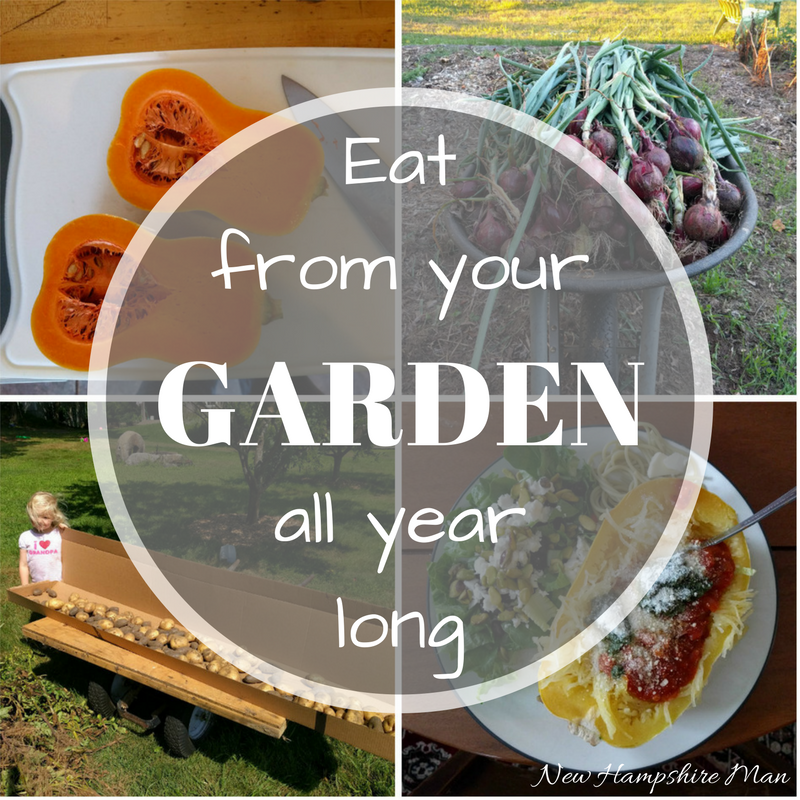
Important factors to extend the joy
I’ll share with you in just a sec the plants that have become standard in my garden for eating all year, but first, here are the things I look for in a plant that I want to put the energy into growing.
First: It must be relatively easy to grow. Time is too valuable at this stage in life to dick around with stubborn plants or to suffer huge losses.
Second: It must be easy to put up. I love me some tomatoes, but it’s a bear to turn all those ‘maters into canned sauce. I look for plants that require minimal processing to go into long term storage.
Third: It must store like a champ. Again, if I’m putting all this energy into it I don’t want to walk into my larder to find it all rotted out.
Check out these winners
Onions
You’re not going to eat onions for dinner, but you are going to eat onions with everything you eat almost all the time.
Onions are super easy to grow and they have almost no pests. Look for varieties that have ‘store well’ in their description and buy sets, not seeds.
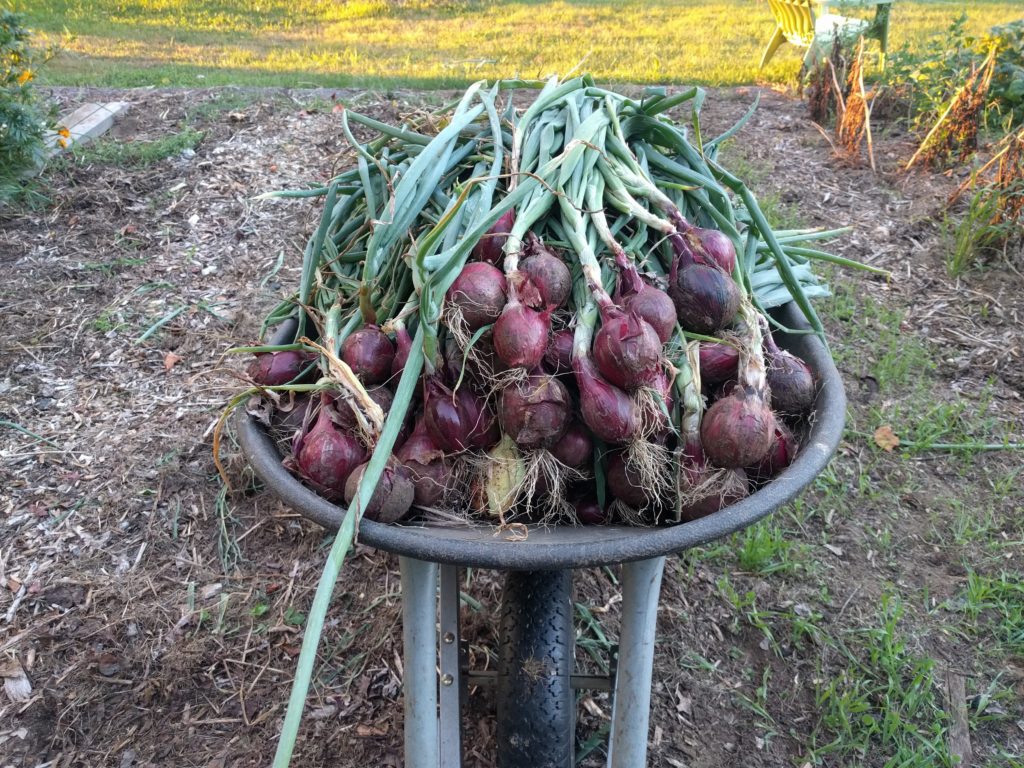
For example, I buy Johnny’s Redwing onion sets. They send a bunch of small plants at the right time in the spring, called sets. Once they show up I put them in the ground and mulch them in with a light layer of compost and grass clipping mix. Weed them a few times a year and hook them up with some more composted mulch.
Once a few of the stalks bend over in late summer I pull them out of the ground and leave them on the side of the garden for a day or so to cure. Then put them in the basement (use a dehumidifier to keep humidity less than 50%) and eat them all year until the spring onions are coming in.
For your reference, this year, 2018, we’re putting 5 units of redwing onions in for a family of 2 onion eaters.
Garlic
I have to shout this from the roof top.
Whenever you start feeling a scratchy throat get yourself a teaspoon of raw local honey and put little slices of one clove of raw garlic on top. Chew that up and swallow down every night from you get the first inkling of a cold, until you’ve kicked it.
Cross my heart dude. Do that.
As if that weren’t reason enough to grow all the garlic you’re going to eat all year. How’s this…it’s also super easy.
Get cloves from a trusted source in the fall and put them in the ground a couple inches deep, pointy side up. Layer up a little mulch and let them be all winter. In the spring, they’ll poke up and grow out. Do nothing but minor weeding and mulching.
If you get hardneck varieties you can also get garlic scapes, which are the bomb. Or do soft neck and make braids. Also the bomb.
Garlic is the bomb.
Late summer some of the leaves will go yellow. Pull the bulbs out, let them cure for a day in the sun, and put them in the basement (use a dehumidifier to keep humidity less than 50%).
I sourced some bulbs from a local farm a few years ago and haven’t bought garlic since. That’s because after you harvest garlic you can split the bulbs and plant the cloves in the fall and it will make you a bulb out of that clove the next year.
Never Buy Garlic Again Ever.
Potatoes
Poster child for ‘How To Get Kids to Enjoy the Garden’.
Diggin’ for ‘taters.
Such a hoot
But not what this is about.
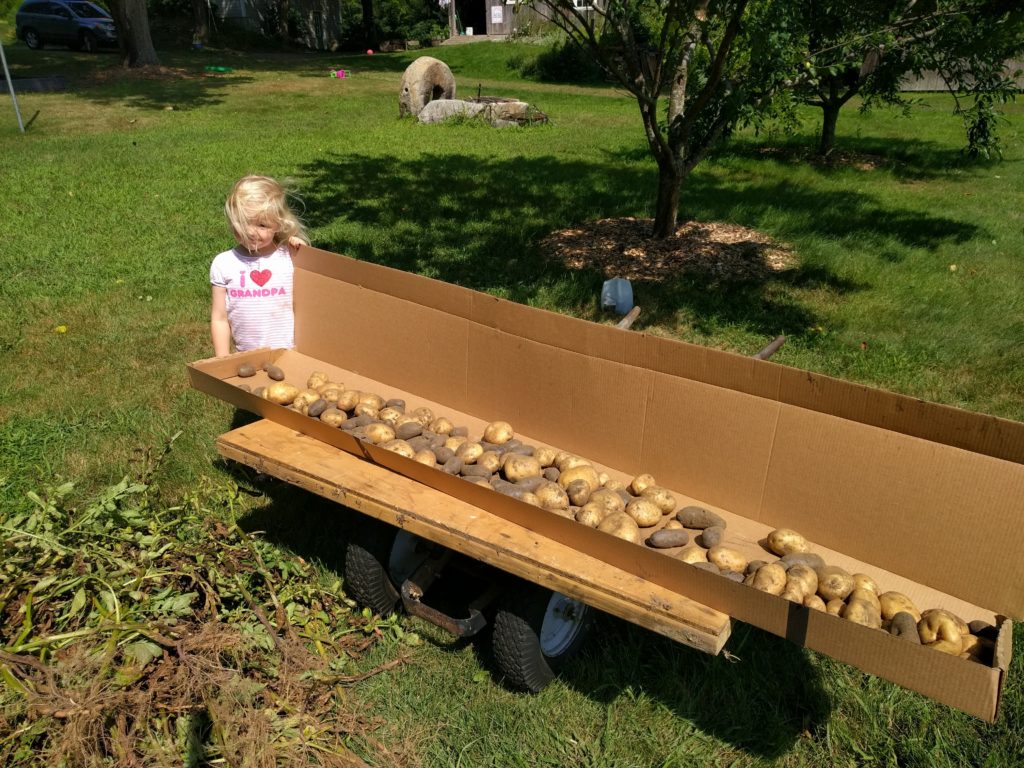
You can actually make your dinner meal around potatoes. We do it about once a week. ‘Taters and ‘kraut. I look forward to it every week, never gets old.
Look for a ‘good storage’ variety. Again, super easy. They’ll send you whole potatoes, called seed potatoes. Cut them in half or quarters making sure each piece has an eye, and bury them in the ground. As they grow, pile up some dirt around them. They’ll keep climbing and making tubers along the way. I’ve hear of piling up tires, or doing them in hay bales, but I’ve always just done them in the garden.
Yes – The potato beetle. Don’t buy the hype. Don’t spray. You’re not growing enough for it to be a big deal. You’ll grow an eye for them and every morning that your out there take a minute or two to pick the beetle or the larvae off your plants and squish them between your thumb and forefinger. The first two are gross, it’s almost rewarding after that.
The plants will die off in the late summer. Grab the kids and a pitch fork and start fishing for taters. As you pull them up brush the loose dirt off them, but DON’T WASH THEM.
Put them on a rack in the basement and eat them all year.
If you grow enough you can take what’s left in the spring and cut them up and replant them. I’ve never grown enough to do that and would research potential disease risks before doing so. Cross that bridge when you get to it.
For reference, in 2018 I’m planting 15 pounds of Johnny’s Yukon Gold. I grew these last year and they are an awesome all-purpose potato that stored quite well for as long as they lasted – late winter.
Butternut Squash
This can also be a meal in and of itself.
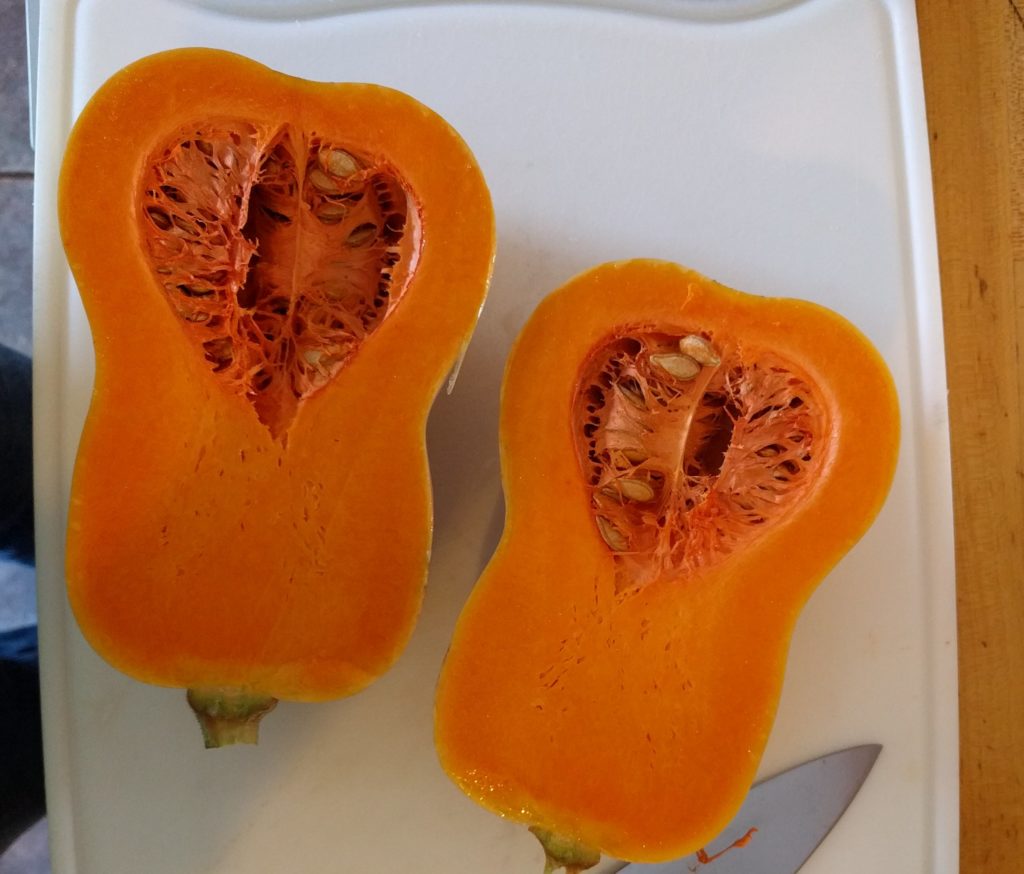
At our house we try to put up 50 butternut squash a season so that we can have one a week all year(ish).
That’s the centerpiece of one dinner a week all year long out of the garden, and it’s not hard.
I’ll concede though, squash does roam, and it does require a bit of space. But, a dinner a week all year beats mowing a lawn, if you know what I’m saying.
Follow planting instructions on the seed packet. It’s a warm weather crop so it goes in kind of late so just be good about weeding around it to get it started. Once it takes it will shade out everything so weeds become less of an issue.
Heavy feeder, so be generous with the compost and water. Consider rotating the fruits once or twice a season so that they color up evenly. I’ve also heard of putting them on paper plates, but haven’t tried that yet.
Squash beetles suck. I clean them off by hand sometimes, but don’t worry much about it most of the time. I try to grow enough volume so that some losses are acceptable. Check the description, but expect 2 to 4 squash per plant.
Once the squash are all firmed up, wipe them down with a 10% bleach solution and put them in a mesh bag, like what onions in the store come in, and hang them in the basement (use a dehumidifier to keep humidity less than 50%).
If there are any imperfections in the skin they can rot, so eat the questionable ones first. Otherwise, these too will store like champs.
And they’re so good.
Cube it and roast it with some maple syrup for a killer side, or eat butternut squash soup all winter with a little dollop of sour cream in the center.
Dang!
Ok. Moving on.
Spaghetti Squash
Read everything about butternut squash. The growing and storing is all the same.
Again, we try to put up 50 a year and eat spaghetti squash once a week at dinner all year.
Cut in half and cook flat side down in a pan with a little water. When a fork easily pulls out the strands it’s done. Hoss in a little sauce and sausage and mix it all up in the rind. Another one to look forward to all week.
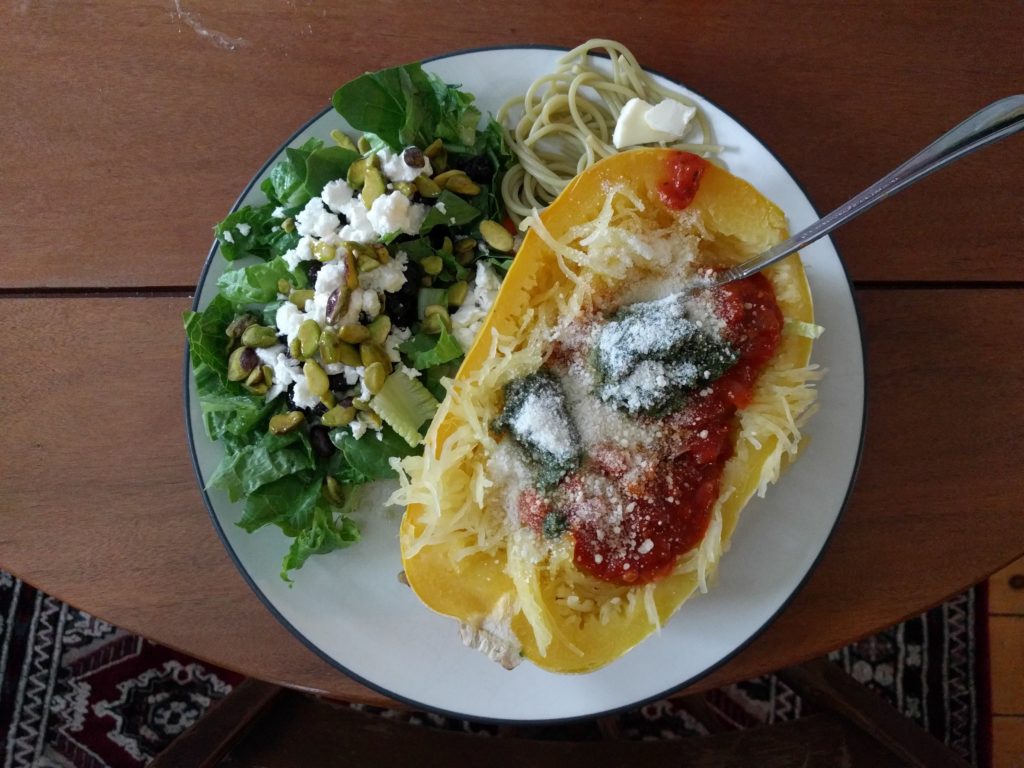
Dried (black) Beans
I say black beans because that’s what we eat the most of, but really, any dried bean is super easy to grow and it stores like a champ.
It’s a little more work to get it put up, but it’s another one you can make a fun activity with the kids out of.
Grow like any other bean, just leave them on the vine all summer. I hung mine in the barn for a while after harvesting, but probably didn’t have to.
If you hit the bean with a hammer and it shatters rather than splats, you’re good to go.
Take all the pods off the plant and put them in a pillow case.
Tell your kids to dance on the pillow case while you hold the end so it doesn’t come open. (Threshing)
Poor the insides from bucket to bucket with a fan blowing between the buckets. The fan will blow most of the chaff away and soon you’ll just be pouring beans back and forth. (Winnowing)
Put the beans in a mason jar in the pantry. My family has been enjoying Johnny’s Midnight Black Turtle beans in soups and on rice and in tacos and Mexican salads and in soup and so on.
These can also be replanted in the spring if you want more of them.
Cabbage
Saved for last because it’s a bit of a stretch, but I want you to think about it.
If you, like me, want to live as long as possible, start fermenting foods. And if you’re going to start, there’s no better place than sauerkraut from homegrown cabbage.
Cabbage is a cool weather crop, so it goes in early, or late. It’s great fresh, but what I’m suggesting is you grow 2 rounds of cabbage and do 2 batches of 5 gallons of kraut.
Not the easiest plant to grow.
Not the easiest to ferment, mainly because you need the equipment (scale and fermenting vessel).
But something to get you thinking about for down the road.
I’ll be doing a post on making sauerkraut in the future, and when I do I’ll link to it here.
Get the biggest bang for your buck, time, and energy
It’s worth underscoring just how rewarding it is to be enjoying a meal from the garden in the middle of a snow storm. It’s something that has brought me great pride over the years and I try to remember to make it a point to remind everyone at the dinner table that the food we’re enjoying was grown at home.
Also, it’s a lot of work to grow food. I respect the people that make a hobby out of it and grow 7 different varieties of tomatoes because it’s such a cool fruit, but the practical side of me says that the time spent should last as long as possible.
Get the biggest bang for your buck, and your time.
Let me know how it goes!

